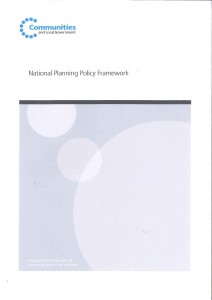
Well its finally arrived! Along with all those involved in the environmental field, Landscape Architects up and down the land will have been poring over the new documents of the NPPF in the last week since it came into force. We have been inundated with commentaries from numerous planning consultants, environmental lawyers and indeed our own Landscape Institute (Chief Exec Alistair McCapra providing a particularly good one from our perspective).
It would appear to have been remarkably well received by the professional community (always likely to have been its most vocal critics) given the radical extent of hacking back from previous guidance and the controversy over the first draft.
Of immediate interest to us for projects in hand, it was good to note there is a 12 month transitional period to take account of the changing goalposts (though I can imagine this, along with rather a lot of other things lost with the detail, will lead to some inevitable confusion ..and increased work for planning inspectors and lawyers in the short term at least) and that one of the most renowned policies of the now defunct PPS7 – the enablement of building a dwelling of exceptional quality or innovative design in the countryside – is carried forward in the NPPF.
The keystone of the planning system still remains the Local Development Plan and that will still determine by far the majority of all planning matters but of particular interest to me as Chair of our community’s emerging Parish Plan, is that neighbourhood plans are now an inherent part of the framework and future planning system. While they will have to be synchronised with Local Authority (in our case East Hants District Council and South Downs National Park) Local Development Plans, where outside core strategies, the Parish Plan could take precedent. We could go as far as set policies to determine decisions on certain planning applications and via the Parish Council even have powers to use Neighbourhood Development Orders and Community Right to Build Orders for specific developments. To quote the documents introductory sentence on Neighbourhood Plans; ‘Neighbourhood planning gives communities direct power to develop a shared vision for their neighbourhood and deliver the sustainable development they need’…and sustainability is now clearly defined in the NPPF as a balance between economic, social and environmental factors…not just the latter as so often misinterpreted by some. Clearly this is a mandate for ‘growth’ and simply maintaining the status quo or promoting NIMBYism is not an option.
Attending a Community Forum organised by EHDC on exactly this topic last night , it was clear the working of all this is clearly in its infancy and the procedures and costs to take a Neighbourhood Plan (and that Defines Parish Plan as well) to Neighbourhood Development Plan or Development Order status would most likely be prohibitive and indeed unneccessary for most communities. The secret appears to lie in closer dialogue with the Local Authority and this is to be welcomed.
Back to the wider stage and its important to realise the NPPF does not allow some kind of free for all for all development; the countryside and green belt is still protected and brownfield, town centre and good design promoted. As the LI commentary and its subsequent correspondence highlight, we as Landscape Architects need to continue to promote Landscape Character Assessment and Green Infrastructure as vital cogs in the Planning Process in spite scant mention in the document.
As ever, the challenge is to embrace the changes and move forward. Good luck!